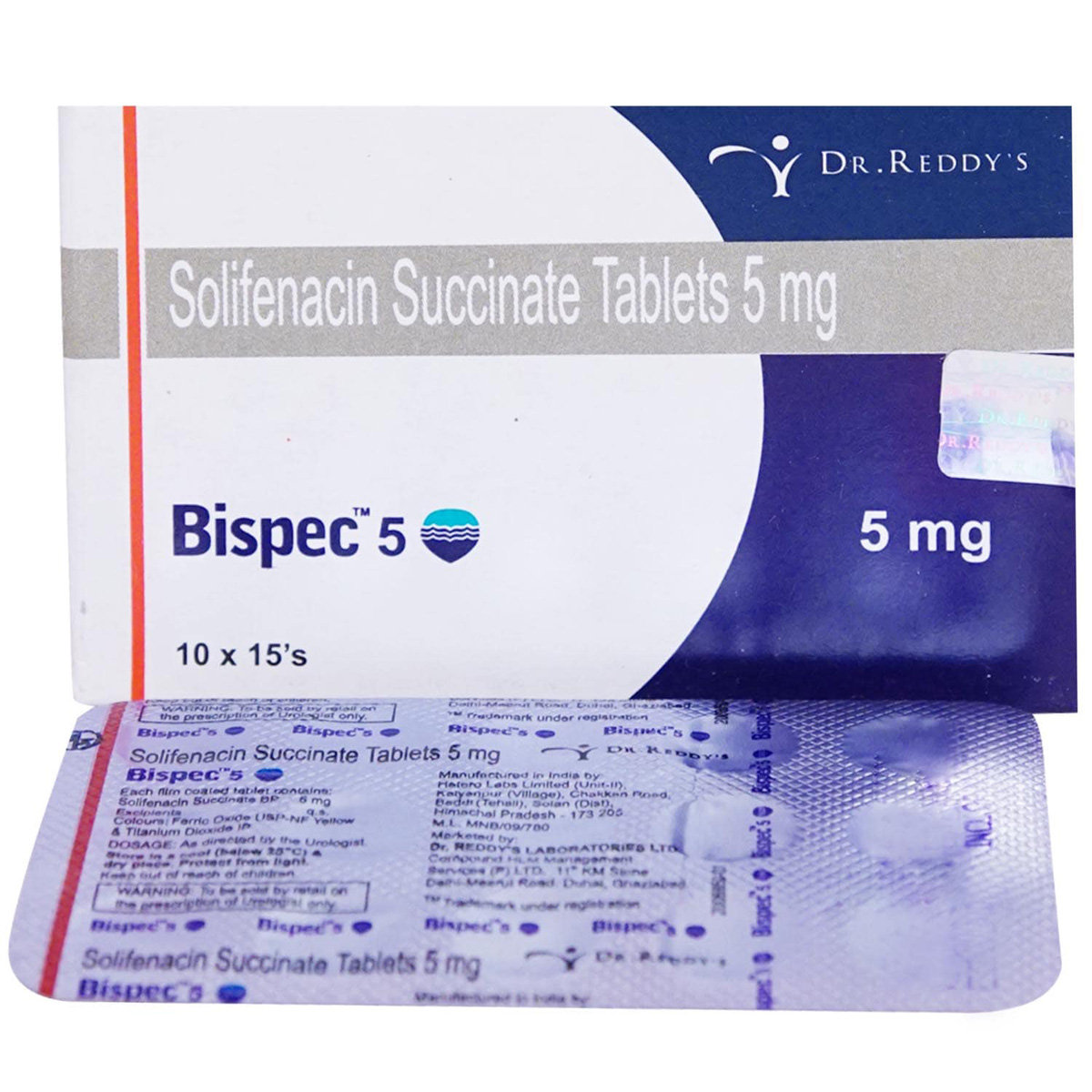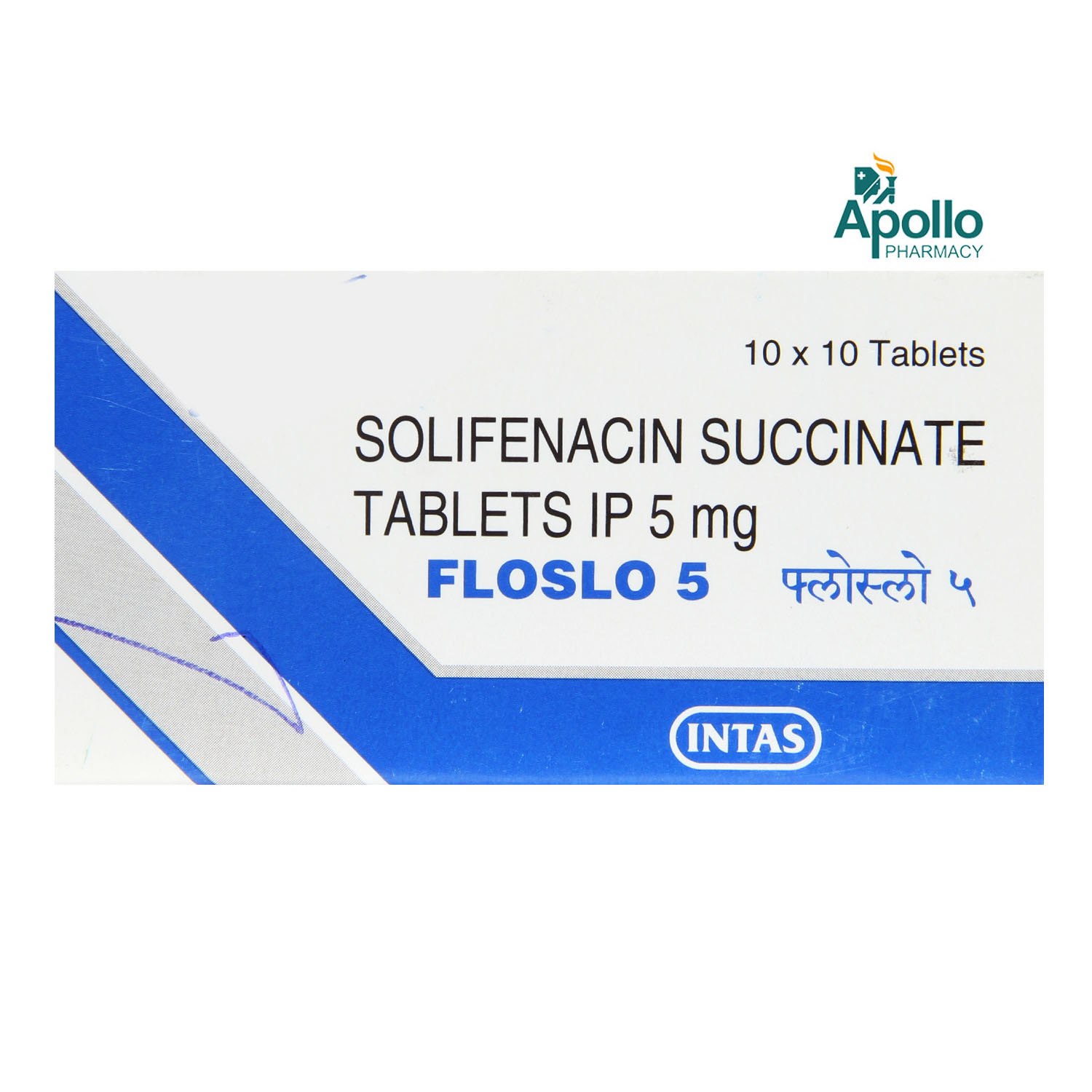Solifenacin
About Solifenacin
Solifenacin belongs to the group of medications called ‘urinary antagonists' or 'antispasmodics' primarily used in the treatment of overactive bladder (OAB) symptoms. Overactive bladder is a condition in which the urinary bladder muscles constrict uncontrollably, thereby causing an urgent need to urinate, frequent urination, and inability to control urination. Besides this, Solifenacin is also used for the treatment of neurogenic detrusor overactivity (a bladder control condition caused by neurological problems) in children 2 years and above.
Solifenacin contains ‘Solifenacin’ that relaxes the urinary bladder muscles which in turn decreases the activity of the overactive bladder. In an overactive bladder, muscle contractions occur before the full expansion of the bladder causing the patient to have frequent urges to urinate. Solifenacin stops these sudden contractions of urinary bladder muscles thereby enabling control over urination. Thus, it increases the amount and volume of urination that can be held by your bladder.
Take Solifenacin as prescribed by the doctor. Common side-effects of Solifenacin are dry mouth, blurred vision, constipation, nausea, dyspepsia (indigestion), abdominal pain, burping or belching, heartburn, and stomach upset. Inform your doctor if these side effects do not go away or get worse.
Do not take Solifenacin if you are allergic to ‘solifenacin’ or any other ingredients present in it. Before taking Solifenacin, inform your doctor if you have kidney disease, liver disease, bladder blockage, myasthenia gravis (a muscle disease), stomach or bowel problems (including constipation), glaucoma (increased pressure in the eye causing loss of vision), or a history of heart rhythm problems (including QT prolongation). Also, inform your doctor if you are pregnant or breastfeeding. Inform your doctor if you have an intolerance to sugars as this medicine contains lactose. Do not take grapefruit or grapefruit juice with this medication. Avoid driving or operating heavy machinery as this medicine may cause dizziness.
Uses of Solifenacin
Medicinal Benefits
Solifenacin contains ‘solifenacin’ that belongs to the class of medications called 'anticholinergics'. It can decrease the activity of the overactive bladder. In an overactive bladder, muscle contractions occur before the full expansion of the bladder causing the patient to have frequent urges to urinate. Solifenacin can stop these sudden contractions of bladder muscles. It enables control over urination and increases the amount of urine that can be held by your bladder.
Directions for Use
Storage
Side Effects of Solifenacin
- Dry mouth
- Blurred vision
- Constipation
- Nausea
- Dyspepsia (indigestion)
- Urinary tract infections
- Blurred vision
- Abdominal pain
- Burping or belching
- Heartburn
- Stomach upset
Drug Warnings
Do not take Solifenacin if you are allergic to ‘solifenacin’ or any contents of it. Before taking Solifenacin, inform your doctor if you are pregnant or breastfeeding or if you have kidney disease, liver disease, bladder blockage, controlled narrow-angle glaucoma, or stomach or bowel problems (including constipation), or a history of heart rhythm problems (including QT prolongation). Solifenacin has lactose, so inform your doctor if you have an intolerance to any sugars. Solifenacin may cause dizziness or blurred vision. So, do not drive or operate any heavy machinery. It can increase body temperature by decreasing sweating. So, avoid hot weather or doing strenuous exercise as this may cause overheating leading to unwanted effects.
Drug Interactions
Drug-Drug interactions: Solifenacin may interact with other anticholinergic medicines, cholinergic drugs, gastrointestinal agents (metoclopramide and cisapride), antifungal drugs (ketoconazole and itraconazole), drugs used to treat HIV (ritonavir and nelfinavir), antihypertensives (verapamil and diltiazem), antibiotic (rifampicin), antiepileptic drugs (phenytoin and carbamazepine), and bisphosphonates.
Drug-Food interactions: Do not take grapefruit or grapefruit juice while using Solifenacin.
Drug-Disease interactions: Solifenacin should be used with caution in patients with urinary retention (inability to urinate), severe stomach or bowel conditions, myasthenia gravis (a muscle disease), glaucoma (eye problem), kidney dialysis, severe liver disease, and severe kidney disease.
Drug-Drug Interactions Checker List:
Safety Advice

Alcohol
cautionAvoid taking alcohol as it increases the risk of side-effects.

Pregnancy
unsafeSolifenacin is a category C medicine. It should be used in pregnant women if the benefits outweigh the risks.

Breast Feeding
cautionSolifenacin should be used in breastfeeding mothers only if clinically needed.

Driving
cautionSolifenacin may cause dizziness and blurred vision. So, avoid driving or operating heavy machinery after using Solifenacin.

Liver
cautionSolifenacin should be used with caution in patients with liver diseases. Dose adjustments may be necessary.

Kidney
cautionSolifenacin should be used with caution in patients with kidney diseases. Dose adjustments may be necessary.

Children
cautionSolifenacin should not be used in children below 12 years of age unless prescribed by a doctor.
Habit Forming
Diet & Lifestyle Advise
- Eat fresh fruits like pears, banana, citrus fruits, and green vegetables like beans and potatoes.
- Try to take cranberry juice as it helps in minimizing urinary infections.
- Avoid coffee, tea, and carbonated drinks which contains caffeine.
- Do not consume processed, fried, or spicy foods, as these foods can irritate your bladder.
- Limit alcohol intake as it can increase the risk of side-effects.
- Quit smoking and exercise regularly.
Special Advise
- Solifenacin is not recommended for the children less than 2 years of age.
- Intake of Solifenacin can make you sweat less, thereby increasing the chance of having a heat stroke in summer. So avoid doing tasks which may cause to overheat.
- Intake of Solifenacin may occasionally cause blurry vision and dizziness so avoid driving a motor vehicle, operate heavy machinery and performing hazardous tasks which require mental alertness as well.
Patients Concern
Disease/Condition Glossary
Overactive bladder (OAB): In normal conditions, when the urinary bladder is filled with urine, it sends a message to the brain that an individual is ready to urinate. During the urination process, bladder muscles contracts which ultimately leads to a uniform flow of urine. Contrary to this, in Overactive bladder (OAB), the urinary bladder muscles start contracting before the urine is filled in the urinary bladder, thereby causing frequent urges to urinate. Solifenacin prevents these sudden bladder muscle contractions and increasing the volume and amount of urine that the bladder can hold. Thus, Solifenacin helps to control the release of urine and helps reduce symptoms of OAB like a strong urge to urinate, frequent urination and reduced urine flow.
FAQs
Solifenacin is used to treat an overactive bladder in which an individual is unable to control urination and always have a strong urge to urinate. Solifenacin prevents these sudden bladder muscle contractions and increasing the volume and amount of urine that the bladder can hold. Thus, Solifenacin helps to control the release of urine and helps reduce symptoms of OAB like a strong urge to urinate, frequent urination and reduced urine flow.
Solifenacin may cause blurred vision in some cases. Consult your doctor immediately if this condition persists or worsens while using this medicine.
Ketoconazole is an antifungal medicine and it may interact with Solifenacin. So, inform your doctor about all the prescription and non-prescription medicines before taking Solifenacin to avoid unwanted effects.
Dry mouth, constipation, urinary tract infection and blurred vision are some of the common side effects of Solifenacin.
If you have bladder problems, stomach problems, narrow-angle glaucoma, liver/kidney problems and irregular heartbeat, please contact a doctor before taking Solifenacin.
Dry mouth is the most common side effects of Solifenacin, so you can drink plenty of fluids or water, suck hard candy or ice chips, chew (sugarless) gum, or use a saliva substitute. However, if you are a kidney patient before taking any fluid or electrolytes, it is better to consult a doctor.
If you are taking antidiabetic medicines (pramlintide), potassium tablets and antifungals (like itraconazole, ketoconazole), among others, let your doctor know about these drugs before using Solifenacin. These medicines may affect the working of Solifenacin and slow its excretion from the body.






